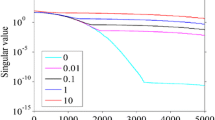Abstract
The Robinson convolution model is mainly restricted by three inappropriate assumptions, i.e., statistically white reflectivity, minimum-phase wavelet, and stationarity. Modern reflectivity inversion methods (e.g., sparsity-constrained deconvolution) generally attempt to suppress the problems associated with the first two assumptions but often ignore that seismic traces are nonstationary signals, which undermines the basic assumption of unchanging wavelet in reflectivity inversion. Through tests on reflectivity series, we confirm the effects of nonstationarity on reflectivity estimation and the loss of significant information, especially in deep layers. To overcome the problems caused by nonstationarity, we propose a nonstationary convolutional model, and then use the attenuation curve in log spectra to detect and correct the influences of nonstationarity. We use Gabor deconvolution to handle nonstationarity and sparsity-constrained deconvolution to separating reflectivity and wavelet. The combination of the two deconvolution methods effectively handles nonstationarity and greatly reduces the problems associated with the unreasonable assumptions regarding reflectivity and wavelet. Using marine seismic data, we show that correcting nonstationarity helps recover subtle reflectivity information and enhances the characterization of details with respect to the geological record.
Similar content being viewed by others
References
Bickel, S. H., and Natarajan, R. R., 1985, Plane-wave Q deconvolution: Geophysics, 50, 1426–1439.
Canadas, G., 2002, A mathematical framework for blind deconvolution inversion problems: 72nd Ann. Soc. Expl. Geophys. Mtg., Expanded Abstract.
Curry, W., 2003, Interpolation of irregularly-sampled data with non-stationary, multi-scale prediction-error filters: 73rd Ann. Soc. Expl. Geophys. Mtg., Expanded Abstracts, 1913–1916.
Dondurur, D., 2010, An approximation to sparse-spike reflectivity using the gold econvolution method: Pure and Applied Geophysics, 167, 1233–1245.
Griffiths, L. J., Smolka, F. R., and Trembly, L. D., 1977, Adaptive deconvolution: A new technique for processing time-varying seismic data: Geophysics, 42, 742–759.
Guitton, A., 2004, Amplitude and kinematic corrections of migrated images for nonunitary imaging operators: Geophysics, 69(4), 1017–1024.
Hargreaves, N. D., and Calvert A. J., 1991, Inverse Q filtering by Fourier transform: Geophysics, 56, 519–527.
Ismail, S., 2008, Nonstationary filters: PhD. Thesis, University of Calgary, 2008.
Kjartansson, E., 1979, Constant Q-wave propagation and attenuation: Journal of Geophysical Research, 84,B9, 4737–4748.
Koehler, F., and Taner, M. T., 1985, The use of the conjugate-gradient algorithm in the computation of predictive deconvolution operators: Geophysics, 50, 2752–2758.
Lazear, G. D., 1993, Mixed phase wavelet estimation using fourth order cumulants: Geophysics, 58, 1042–1051.
Levy, S., and Oldenburg, D. W., 1987, Automatic phase correction of common-midpoint stacked data: Geophysics, 52, 51–59.
Longbottom, J., Walden, A. T., and White, R. E., 1988, Principles and application of maximum kurtosis phase estimation: Geophysical Prospecting, 36, 115–138.
Ma, Y., and Margrave, G. F., 2008, Seismic depth imaging with the Gabor transform: Geophysics, 73(3), S91–S97.
Margrave, G. F., 1998, Theory of nonstationary linear filtering in Fourier domain with application to timevariant filtering: Geophysics, 63, 244–259.
Margrave, G. F., Henley, D. C., and Lamoureux, M. P., et al., 2003, Gabor deconvolution revisited: 73th Ann. Soc. Expl. Geophys. Mtg., Expanded Abstract, 714–717.
Margrave, G. F., Lamoureux, M. P., and D. C. Henley, 2011, Gabor deconvolution: Estimating reflectivity by nonstationary deconvolution of seismic data: Geophysics, 76, W15–W30.
Margrave, G. F., Lamoureux, M. P., Grossman, J. P., and Iliescu, V., 2002, Gabor deconvolution of seismic data for source waveform and Q correction: 72nd Ann. Soc. Expl. Geophys. Mtg., Expanded Abstracts, 2190–2193.
Montana, C. A., and Margrave, G. F., 2005, Phase correction in Gabor deconvolution: 75th Annual International Meeting, Expanded Abstracts, 2173–2176.
O’Doherty, R. F., and Anstey, N. A., 1971, Reflections on amplitudes: Geophysical Prospecting, 19, no. 3, 430–458.
Rosa, A. L. R., and Ulrych, T. J., 1991, Processing via spectral modeling: Geophysics, 56, 1244–1251.
Sacchi, M. D., 1997, Reweighting strategies in seismic deconvolution: Geophys. J. Int., 129, 651–656.
Sun, X. K., Sun, Z. D., and Peng, T. et al., 2012, Gabor Deconvolution: Hyperbolic Smoothing in Logarithmic Magnitude Spectrum: 82nd Ann. Soc. Expl. Geophys. Mtg., Expanded Abstract, 2012.
Sun, X. K., Sun, Z. D., and Zhou, X. Y., et al., 2013, Gabor deconvolution based on hyperbolic smoothing in log spectra: 75th EAGE Conference & Exhibition, Extended Abstract.
Sun, Z. D., Yang, H., and Zhang, Y. et al., 2011, The application of amplitude-preserved processing and migration for carbonate reservoir prediction in the Tarim Basin, China: Petroleum Science, 8, 406–413.
Van der Baan, M., and Pham, D.T., 2008, Robust wavelet estimation and blind deconvolution of noisy surface seismic: Geophysics, 73, V37–V46.
Velis, D. R., 2008, Stochastic sparse-spike deconvolution: Geophysics, 73(1), R1–R9.
Walden, A. T., and Hosken, J. W. J., 1986, The nature of the non-Gaussianity of primary reflection coefficients and its significance for deconvolution: Geophysical Prospecting, 34, 1038–1066.
Wang, Y., 2006, Inverse Q-filter for seismic resolution enhancement: Geophysics, 71, V51–V60.
Wiggins, R., 1978, Minimum entropy deconvolution: Geoexploration, 16, 21–35.
Liu, G. C., 2012, Theory and Application of Nonstationary Filtering in Seismic Data Analysis: Doctor Thesis, China University of Petroleum (Beijing).
Liu, X. W., Ning, J. C., and Zhang, G. L., 2009, Cauchy sparse constrained Bayesian estimation based seismic blind deconvolution frame and algorithm: Geophysical Prospecting for Petroleum, 48(5), 459–464.
Zhang, F. C., Liu, J., Ying, X. Y., and Yang, P. J., 2008, Modified Cauchy-constrained seismic blind deconvolution: Oil Geophysical Prospecting, 43(4), 391–396.
Author information
Authors and Affiliations
Corresponding author
Additional information
This research is funded by the National Basic Research Program of China (973 Program) (Grant No. 2011CB201100) and Major Program of the National Natural Science Foundation of China (Grant No. 2011ZX05004003).
Sun Xue-Kai graduated from China University of Mining and Technology (Xuzhou) in 2008 with a B.S. in Geophysics. He received his M.S. in Solid Geophysics from China University of Mining and Technology (Xuzhou) in 2011. He is currently a Ph.D. student at the China University of Petroleum (Beijing). His main research interests are seismic data processing and inversion, including resolution enhancement, and anisotropic migration and fracture prediction.
Rights and permissions
About this article
Cite this article
Sun, XK., Sam, Z.S. & Xie, HW. Nonstationary sparsity-constrained seismic deconvolution. Appl. Geophys. 11, 459–467 (2014). https://doi.org/10.1007/s11770-014-0459-8
Received:
Revised:
Published:
Issue Date:
DOI: https://doi.org/10.1007/s11770-014-0459-8




